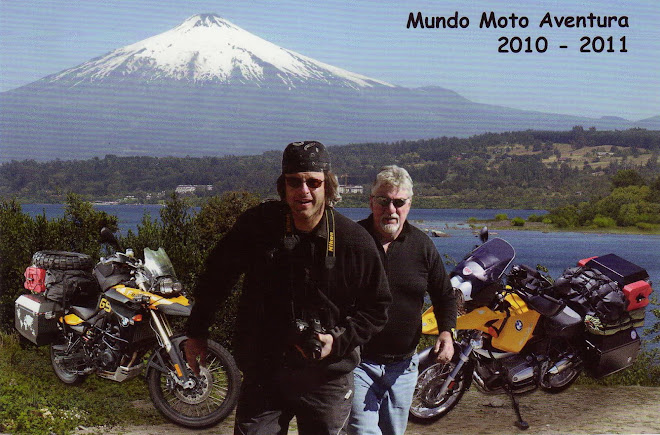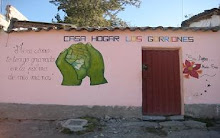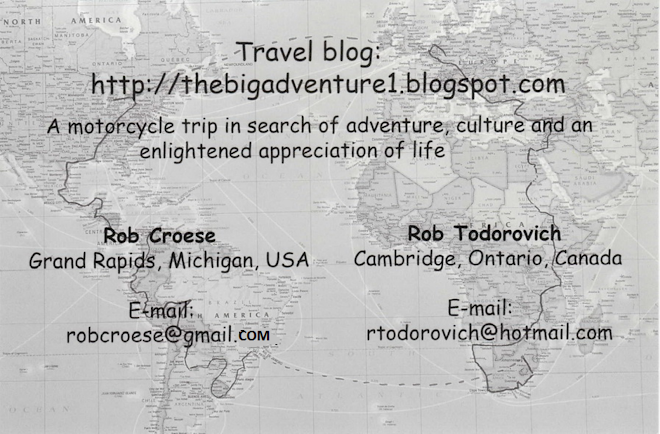Our goal for the day was to try to get to the border town (Bolivia/Argentina) of Villazón, but, again, we were given contradicting information as to what the roads were like. We did know there were 2 routes to the border, one used by tourists, which was longer but had more pavement, and the other, a more commercial route, shorter and less pavement. We were also given information on how much pavement there was. We soon found out that what we did receive by way of information was quite a bit less than accurate.
Little side note: my brakes on the 800GS failed once again, but this time they started failing as we entered La Paz and its steeply inclined roads and streets. Good thing it wasn't a few hours earlier on the Death Road. They were not completely gone as I could get one squeeze of braking before the lever pressed down to the handle bar and there was nothing left. We tried bleeding the brakes in La Paz, as that worked last time in Nicaragua. Not this time; I have now been running with 25% front brakes for one squeeze, 100% rear brakes and engine braking. And yes, I have had to plan my city driving and approaches to mountain corners more carefully. We were going to look for a moto shop at our next stop, in Potosí, as we were told there was one in that town.
Some adobe farm houses along the road. Not sure how these people survive out here, but they do.
View of the valley en route to Potosí.
We notice a strange phenomenon today. Along this seemingly endless, deserted stretch of road, there were children from 5 to 12 years old, all begging for hand-outs. As we approached, they would get up, run to the side of the road, stretch out their hands and form a cup or held a hat. Sometimes they were in groups, other times a solitary child on his/her own. The remarkable thing was we didn't notice any homes or dwellings nearby, anywhere! We searched the landscape and nothing. Where did these kids come from? Were they dropped off by their parents? Don't know and we didn't find out. At one point we came to a toll booth, stopped to pay and were instantly surrounded by these children, begging and pleading, some selling jello in plastic bags. I moved to get passed the booth and one of the kids actually grabbed my arm as I drove by, because I never gave him anything. These poor kids, dirty, torn clothing, red blotchy skin due to sun burn (we were at 3500 meters (10,000 feet) so the sun is strong), in dire need of a dentist. As a father I felt really bad for them as I could only imagine what it would be like if that were my daughter. It's hard to comprehend for someone like me coming from a place like Canada.
Roadside restaurant. These places are actually pretty good and you get soup, main course (rice and some meat) and a bottle of drink for 2 USD.
Local dwellings.
Once again, we asked locals and bus drivers about the rest of the road. We have found that you can't ask too many questions and you can't ask the same question enough because sometimes you do get similar responses and that's what you go with, specially in Bolivia. As we left Potosí, without any luck getting my brakes fixed, we were ready for some more blacktop before getting to gravel. 20 km south of town we hit gravel again. It wasn't too bad at first, but as we went further south it did get worse, so we stopped to let air out of the tires again. The road detoured through every little village along the way. Not sure how this was supposed to be a commercial route (meaning buses and trucks), as we only saw dump trucks with gravel to fill big holes in the road. Also, we couldn't figure out how anything bigger like a bus could navigate through some of these small villages. In places, the road would cross a dry river bed, even follow it for a few kilometers or it would cross a fast moving river where we would first watch a car or truck go through before we actually attempted the crossing.
A detour. You can see the "new" road off to the left.
Long road down to Argentina
Getting closer to our destination proved to be more challenging as the detours ("desvios") became more frequent. Mostly, they were down the embankment of a dried river and up the other side due to bridge construction. Buses and trucks used these detours as well. The sections in between were paved in spots. We did get a nice stretch of road that was concrete. What a relief that was!!!!! The detours didn't stop, but we could handle that.
Along the Bolivian Altiplano
We arrived in Tupiza thinking we'd spend the night there. The rock formations were incredible, almost like something you would see around the Badlands of the US and Canada. The town itself was interesting because it was split in half by a river and there were no bridges across. We looked around and noticed cars and trucks following a path down to the river and up the other side, so that's what we did. On the other side we asked about the road to the border and whether the border was open all night. As suspected, we got differing opinions. We were told by several people that the road was in fact paved all the way to the border. It was getting late, but we decided since the road was good and it was only 90 km, we could do it. We drove back across the river at a different spot, which was much deeper and wider. I almost ended up on my side right there in that smelly river. We both agreed there must have been some sewage runoff into the river because it smelled bad.
Well, as for the paved road to the border .... lets say it was partially paved. Surprise, surprise. It was very difficult negotiating the new, unmarked blacktop at night and looking out for little 6" x 12" signs labeled "Desvio 50 mtrs". Yeah, not much time to slow down and find where it actually was, specially at night. Most of the time they pointed in the correct direction. The detours down through the river beds were either on the right or left side of the road just prior to the bridge construction. Occasionally they pointed straight across and we both reluctantly and very slowly followed that and to our amazement, there was actually a bridge. We made it into Villazón at 7:30pm, at the Bolivia/Argentina border. it was a hard day, but we did 610 km (400 miles) from Oruro to Villazón, a 12-hour day in the saddle.



















i REMEMBER IT FROM 1HE 1940'S. I was a 'carabinero" in Villazon.
ReplyDeleteHenry horwitz